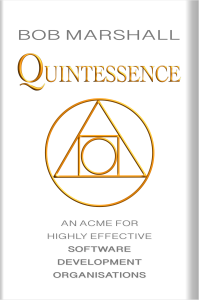Visual Walkthrough Explaining Rightshifting And The Marshall Model
For those who prefer looking to reading, here’s a visual explanation (with some annotations) briefly explaining Rightshifting and the Marshall Model.
1. Context: Organisational Transformation
Rightshifting illuminates the tremendous scope for improvement in most collaborative knowledge work organisations. And the Marshall Model provides a framework for understanding e.g. Digital Transformations. Don’t be too surprised if folks come to regard you as an alien for adopting these ideas.

2. Imagined Distribution of Effectiveness
How most people imagine effectiveness to be distributed across the world’s organisations (a simple bell curve distribution).

3. Contrasting Effectiveness with Efficiency
Many organisations seek efficiency, to the detriment of effectiveness.

4. If Effectiveness Were Distributed Normally

5. The Distribution of Effectiveness in Reality
The distribution of organisations is severely skewed towards the ineffective.

6. Some Corroborating Data from ISBSG (1)

7. Some Corroborating Data from ISBSG (2 – Productivity)

8. Some Corroborating Data from ISBSG (3 – Velocity)

9. Rightshifting: Recap

10. Plotting Levels of Waste vs Effectiveness
Showing how increasing effectiveness (Rightshifting) drives down waste.

11. Plotting Levels of Productivity vs Effectiveness
Showing how increasing effectiveness (Rightshifting) drives up productivity.
NB This the the canonical “Rightshifting Chart”.

12. From Rightshifting to the Marshall Model
Starting out with the Rightshifting distribution.

13. The Adhoc Mindset
Collective assumptions and beliefs (organisational mindset).
“Ad-hoc organisations are characterised by a belief that there is little practical value in paying attention to the way things get done, and therefore few attempts are made to define how the work works, or to give any attention to improving the way regular tasks are done, over time. The Ad-hoc mindset says that if there’s work to be done, just get on and do it – don’t think about how it’s to be done, or how it may have been done last time.”

14. The Analytic Mindset
“Analytic organisations exemplify, to a large extent, the principles of Scientific Management a.k.a. Taylorism – as described by Frederick Winslow Taylor in the early twentieth century. Typical characteristics of Analytical organisation include a Theory-X posture toward staff, a mechanistic view of organisational structure, for example, functional silos, local optimisation and a management focus on e.g. costs and ‘efficiencies’. Middle-managers are seen as owners of the way the work works, channelling executive intent, allocating work and reporting on progress, within a command-and-control style regime. The Analytic mindset recognises that the way work is done has some bearing on costs and the quality of the results.”

15. The Synergistic Mindset
“Synergistic organisations exemplify, to some extent, the principles of the Lean movement. Typical characteristics include a Theory-Y orientation (respect for people), an organic, emergent, complex-adaptive-system view of organisational structure, and an organisation-wide focus on learning, flow of value, and effectiveness. Middle-managers are respected for their experience and domain knowledge, coaching the workforce in e.g. building self-organising teams, and systemic improvement efforts.

16. The Chaordic Mindset
“The Chaordic mindset believes that being too organised, structured, ordered and regimented often means being too slow to respond effectively to new opportunities and threats. Like a modern Jet fighter, too unstable aerodynamically to fly without the aid of its on-board computers, or sailing a yacht, where maximum speed is to be found in sailing as close to the wind as possible without collapsing the sails, a chaordic organisation will attempt to operate balanced at the knife-edge of maximum effectiveness, on the optimal cusp between orderly working and chaotic collapse.”

17. Transition Zones
As organisations progress towards increasing effectiveness, they encounter discontinuities which the Marshall Model labels as Transition Zones (orange hurdles). In these transitions, one prevailing mindset must be replace wholesale with another (for example, Analytic to Synergistic, where, amongst a host of shifts in assumptions and beliefs, attitudes towards staff transition from Theory-X to Theory-Y). Cf. Punctuated Equilibria.

18. What Each Transition Teaches
A successful Adhoc -> Analytic transition teaches the value of discipline (extrinsic, and later, replaced with intrinsic).
A successful Analytic -> Synergistic transition teaches the value of a shared common purpose.
A successful Synergistic -> Chaordic transition teaches the value of “Positive Opportunism”.

19. The Return-on-Investment Sawtooth
Incremental (e.g. Kaizen) improvements with any one given mindset show ever-decreasing returns on investment as the organisation exhausts its low-hanging fruit and must pursue ever more expensive improvements.
Each successful transition “resets” the opportunities for progress, offering a new cluster of low-hanging fruit.

20. Conversation
What has this walkthrough shown you? I’d love the opportunity for conversation.

– Bob

























